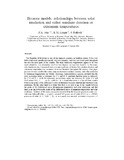| dc.description.abstract | The Republic of Botswana is one of the sunniest countries in Southern Africa. It has very little cloud cover, insufficient rainfall, very low humidity, and very low wind speed throughout the year for most parts of the country. The daily extremum temperatures appear to be very much related to solar irradiation which in turn depends on sunshine duration. In Botswana, solar irradiation on a horizontal surface is measured only at Sebele, but sunshine duration and extremum temperatures are measured at several locations throughout the country. This paper presents bivariate models that relate solar irradiation to sunshine duration, and solar irradiation to extremum temperatures for Sebele, Botswana. Autocorrelation analysis revealed that the solar irradiation series is stationary for d=2 and D=0, sunshine duration series is stationary for d=0 and D=0, while the extremum temperatures series are stationary for either d=0 and D=N where N=1, 2, . . . or d=1 and D=1. It is found that there is a lag of three months between the peaks of the differenced series of fractional sunshine duration and fractional solar irradiation. On the other hand it is found that there is at most a lag of one month between the peaks of the differenced series of maximum temperature and solar irradiation, and that there is no lag between the peaks of the differenced series of minimum temperature and solar irradiation. Analysis of the noise component revealed that the bivariate processes under consideration behaved either as a purely seasonal MA processes of order (0,1,1) or as ARIMA processes of order (0, 1, 1)x (0, 1, 1)12 or as a purely nonseasonal, autoregressive process of order 2. We claim that the relationships found for Sebele can be applied to estimate solar irradiation at other locations with climatic conditions similar to Botswana. | en |

